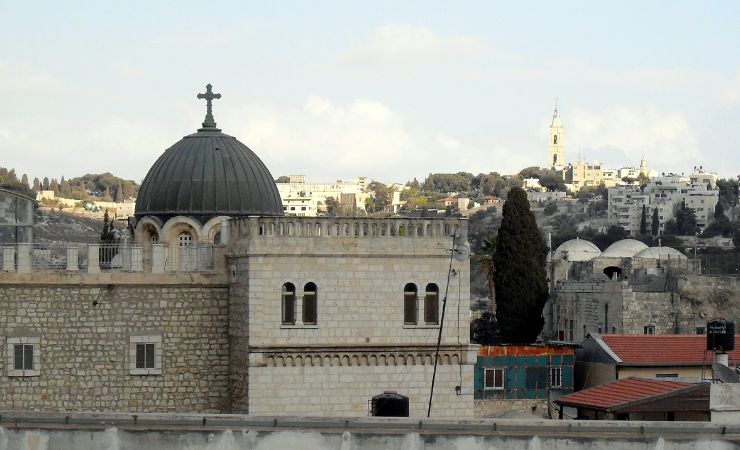The Convent of the Sisters of Zion: Home to the Church of the Ecce Homo
The Convent of the Sisters of Zion is a Roman Catholic establishment founded in 1857. The convent encompasses the Church of Ecce Homo, founded in 1862, also known as the Basilica of Ecce Homo that derives its name from Pontius Pilate’s “Ecce homo” speech, believed to have taken place on the pavement below the church.

Location
The Convent of the Sisters of Zion is strategically located near the beginning (eastern end) of the Via Dolorosa in the Old City of Jerusalem not far away from the Lion’s Gate, the Church of Flagellation, St. Annes Church. This ancient pathway is believed to be the route Jesus took on his way to crucifixion.
Historical context
The convent’s history is intertwined with the city’s past. In the first century BC, Herod the Great constructed a vast open-air pool in the area. Later, in the second century, Roman Emperor Hadrian added arched vaulting over the pool, transforming it into a large cistern of about 544 meters long and 14 meters wide to collect rainwater. Above this, Hadrian erected a triple-arched gateway, serving as an entrance to the eastern forum of the Aelia Capitolina in Jerusalem. The northern arch of this gateway is now preserved under the apse of the Basilica of Ecce Homo, a part of the convent.
The Convent of the Sisters of Zion owes its foundation to Marie-Alphonse Ratisbonne, a French Jew who converted to Catholicism. In 1857, he decided to purchase the site, and by 1862, he had built the Church of Ecce Homo, overlapping part of the ancient gateway. The convent expanded over the years, incorporating surrounding Arab homes and even opening a medical dispensary.



The Modern Church of the Convent of the Sisters of Zion
Ground Level:
Upon entering the Church of Ecce Homo, visitors are greeted by the preserved northern arch of the Aelia Capitolina’s eastern forum gateway, which is situated under its apse. This is part of a triple arched Triumphal gateway from the time of Hardian. The Ecce Homo arch on the Via Dolorosa is the central span of this gateway. The church’s interior is a blend of ancient structures seamlessly integrated with more recent additions.
Below Ground Level:
Venturing beneath the convent, one discovers an expansive area of the Roman flagstones. These flagstones extend, albeit to a lesser extent, under the Church of the Condemnation (first and second stations of the Via Dolorosa). An intriguing aspect of these flagstones was discovered in 1864, which depicts a game played by Roman soldiers. This game involved the enactment of a “mock king.” Due to this etching, the nuns believed these flagstones to be those of Gabbatha, the location described in John 19:13 where Pontius Pilate judged Jesus’ trial. There’s a possibility that after the Antonia Fortress was destroyed, its pavement tiles were relocated to Hadrian’s plaza.
Sources and Additional Reading
See the Holyland – Ecce Homo
Nearby Sites
- Church of the Condemnation: Another significant religious site, believed to be where Jesus took up his cross.
- Church of the Flagellation: A serene sanctuary marking the spot where Jesus was believed to have been scourged.
- The Pool of Bethesda: An ancient pool historically associated with healing miracles performed by Jesus.



